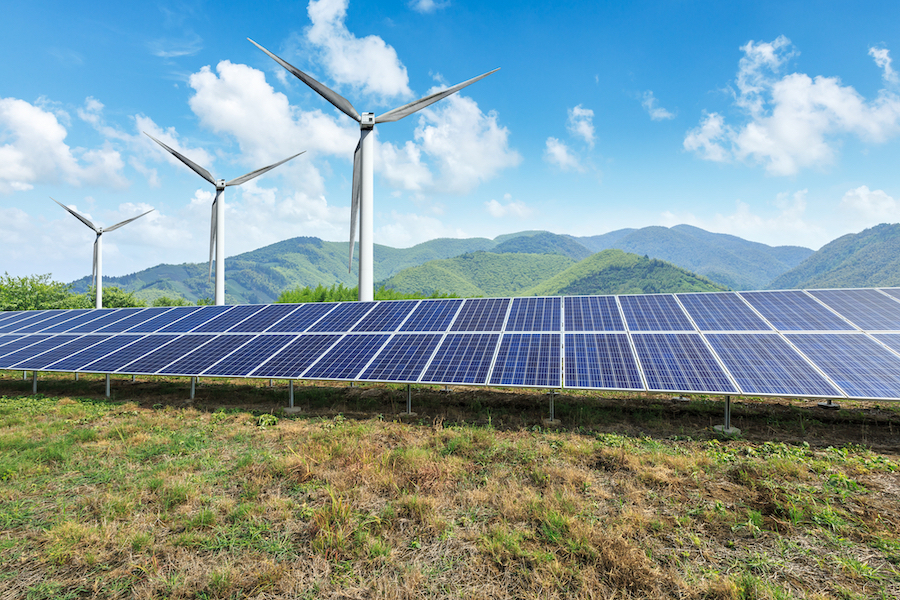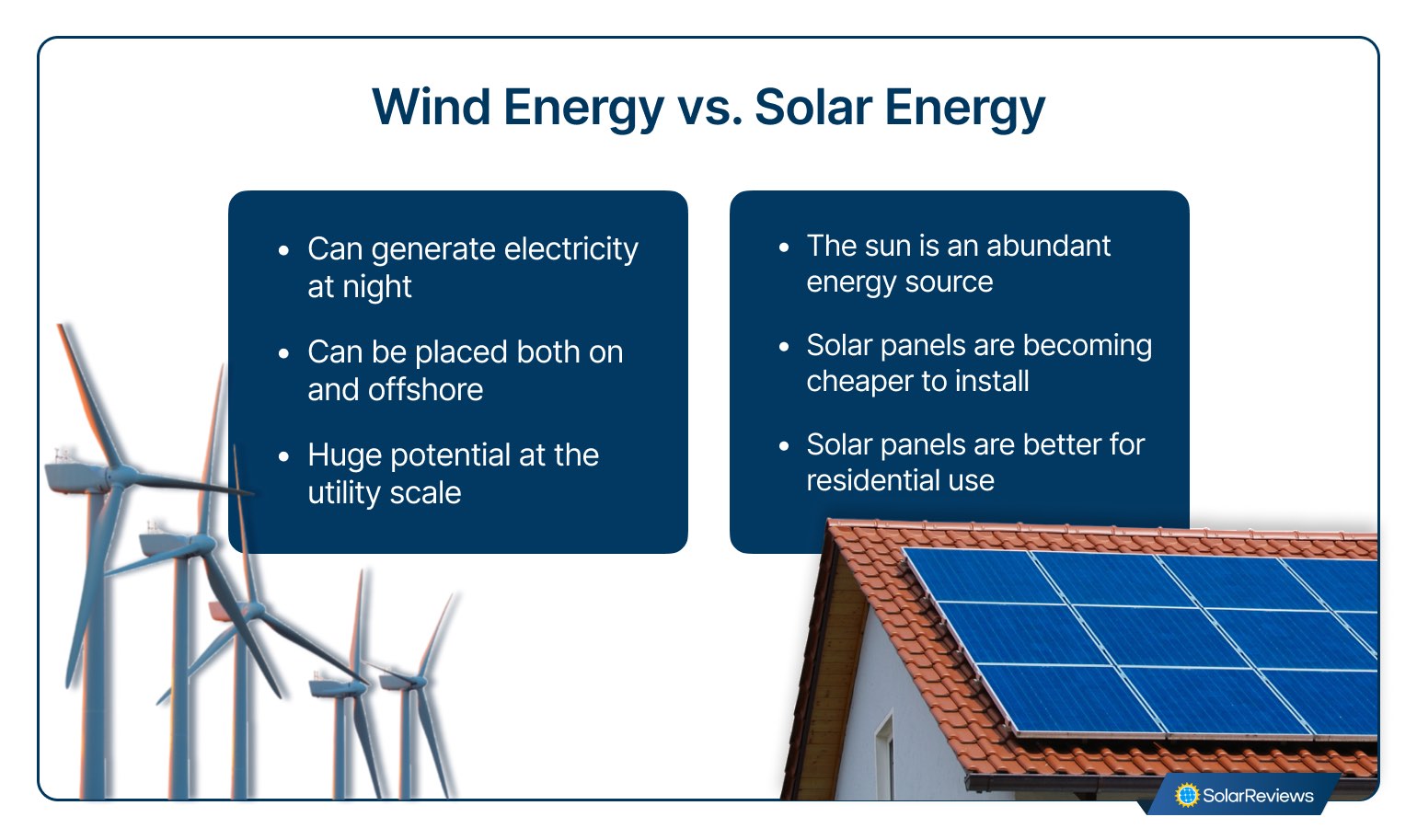Updated 1 year ago
Solar vs. Wind Energy: Which Is Better for Homes?
Written by
Jamie Smith

Find out what how much it costs to power your home with renewable energy
Key Takeaways
-
Solar panels are a more practical option for powering homes, as wind turbines are less developed for residential use and require more specific conditions to work best.
-
Wind power has the most potential in open areas with few structures to block the wind, like in the Great Plains region.
-
Solar energy can be harnessed on almost any scale, from solar phone chargers to large solar farms.
-
Wind farms can be installed both on and offshore, and have the ability to generate electricity at night.
Wind energy vs. solar energy

Solar energy and wind energy are both renewable energy sources that generate clean power. Solar farms and wind power plants can be used to create electricity on a large scale, or small-scale versions can be used to generate power for individual homes.
Residential solar systems use solar panels that are wired together and typically mounted to your roof. As the sun shines, the solar PV panels capture the sunlight and turn it into an electric current that is used by your home. Solar panels are more practical than wind turbines for home use because they are better suited for installation in residential neighborhoods and are a lot cheaper.
Wind power is generated by wind turbines that spin when the wind blows. The spinning turbines power a generator that creates electricity. Though there are residential windmills, they’re quite large and require substantial amounts of open space to operate efficiently. So, wind power is typically used on the utility scale.
When is solar energy the best?
One of the biggest advantages of solar energy is that it can be used just about anywhere on any scale. From small-scale items like solar-powered phone chargers to large solar farms, the technology has plenty of versatility.
When it comes to powering your home with clean energy, solar panels are the best option because they’re relatively affordable, can be installed in a variety of locations, and are more conspicuous than wind turbines.
Keep in mind that home solar panels aren’t for everyone. You’ll need to have a roof facing the right direction for solar so the panels get optimal sun exposure and produce enough power to run your home. Solar panels do work in cloudy weather, but will generate more energy in sunny states like Arizona than in places prone to overcast conditions, like Oregon.
These are a few pros and cons of solar panels:
Pros
-
Saves money on electric bills
-
Great for powering homes or for utility-scale projects
-
Low maintenance costs
Cons
-
High upfront cost
-
Can increase property taxes or homeowners insurance
-
Value depends on local policy
Consider adding battery storage. If you live in cloudier states, don’t have access to strong net metering policies, or live in areas prone to power outages, adding solar energy storage can help you make the most of your solar savings and keep your home running on clean electricity.
When is wind energy the best?
Wind energy offers terrific potential at the utility-scale. A significant benefit of wind power systems is that they can be placed both on and offshore, which allows for more areas where they can be installed. However, they can be a bit unpredictable because wind speeds vary hourly and seasonally.
The efficiency of wind power is measured by the actual amount of kinetic energy that’s converted. When wind hits the turbine, the turbine moves to make energy. Most wind turbines can convert about half of the wind hitting them into usable power. Offshore wind has higher conversion rates because of higher wind speeds.
According to data from the Energy Information Administration (EIA), the five states that generated the most energy from wind power were Texas, Iowa, Oklahoma, Kansas and Illinois – which combined a total of about 59% of total U.S. electricity generation in 2023.
Here are some of the biggest advantages and disadvantages of wind power:
Pros
-
Clean energy source
-
Space efficient
-
Cheap energy
Cons
-
Not practical for most homes
-
Intermittent source
-
Difficult to find an installer
Can you get a wind turbine for home use?
Yes! Small-scale wind turbines can be installed for home use, but residential wind power presents more challenges than solar power. In general, residential wind turbines are best suited for:
Rural homes with enough space to house a wind turbine.
Homes in areas that have high wind potential.
Homes with very high electricity bills.
For a wind electric system to work for your home, you’ll need to live in a vast, open area free of things that could block the wind. Also, you need to ensure no local ordinances or laws prevent you from installing a wind turbine. Wind turbines typically need to be very tall to get enough wind exposure.
In some cases, wind energy systems can be a cost-effective renewable energy source that can lower your electricity bills and provide a way to reduce your carbon footprint – but the conditions need to be just right.
How much does a wind turbine cost?
According to the American Wind Energy Association, a small wind turbine system costs between $3,000 and $5,000 per kilowatt (kW) of generating capacity. This estimate is pretty old, but there isn’t a ton of information about the cost of residential wind turbines because they are so uncommon.
The chart below shows what the average cost would be for residential wind power systems based on different standard system sizes:
System size | Cost |
|---|---|
4 kW | $12,000 - $20,000 |
6 kW | $18,000 - $30,000 |
8 kW | $24,000 - $45,000 |
10 kW | $30,000 - $50,000 |
Should you get a residential wind turbine or solar panels?
Logistically speaking, solar panels are the better option for homes than a wind turbine. This is simply because the residential solar industry is more developed, and it's much easier to find solar installers than wind turbine contractors. Additionally, more homes have the right conditions for solar panels as opposed to wind turbines.
Residential wind systems would only make sense for homes in very rural, open areas – like homes located on a farm. All in all, both methods offer clean, reasonably priced alternatives to fossil fuels. If you’re curious about solar panels being right for your home, put your home’s information into our solar calculator for more information.
Jamie is a Content Writer and researcher at SolarReviews. A recent graduate of La Salle University in Philadelphia, Jamie earned her B.S. in communications with a concentration in journalism, mass media, and public relations. Jamie has previously worked at a marketing company where she had the opportunity to highlight and promote small business owners through long-form stories and interviews. With a deep-rooted passion for creativity, Jamie stri...
Learn more about Jamie Smith